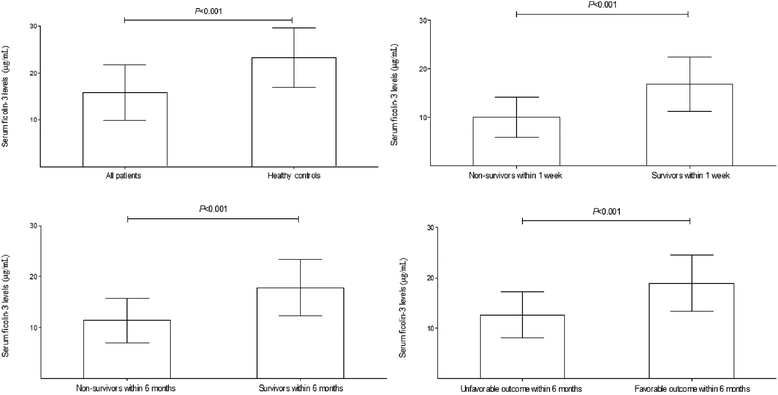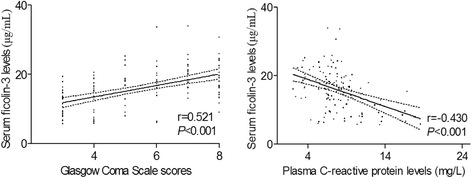Low serum ficolin-3 levels are associated with severity and poor outcome in traumatic brain injury
- PMID: 26627059
- PMCID: PMC4666053
- DOI: 10.1186/s12974-015-0444-z
Low serum ficolin-3 levels are associated with severity and poor outcome in traumatic brain injury
Abstract
Background: Ficolin-mediated activation of the lectin pathway of complement contributes to the complement-independent inflammatory processes of traumatic brain injury. Lower serum ficolin-3 levels have been demonstrated to be highly associated with unfavorable outcome after ischemic stroke. This prospective observatory study was designed to investigate the relationships between serum ficolin-3 levels and injury severity and clinical outcomes after severe traumatic brain injury.
Methods: Serum ficolin-3 levels of 128 patients and 128 healthy controls were measured by sandwich immunoassays. An unfavorable outcome was defined as Glasgow Outcome Scale score of 1-3. Study endpoints included mortality at 1 week and 6 months and unfavorable outcome at 6 months after head trauma. Injury severity was assessed by Glasgow Coma Scale score. Multivariate logistic models were structured to evaluate the relationships between serum ficolin-3 levels and study endpoints and injury severity.
Results: Compared with the healthy controls, serum ficolin-3 levels on admission were statistically decreased in patients with severe traumatic brain injury. Serum ficolin-3 levels were independently correlated with Glasgow Coma Scale scores. Ficolin-3 was also identified as an independent prognostic predictor for 1-week mortality, 6-month mortality, and 6-month unfavorable outcome. Under receiver operating characteristics curves, ficolin-3 has similar prognostic predictive values for all study endpoints compared with Glasgow Coma Scale scores.
Conclusions: It was proposed that lower serum ficolin-3 levels, correlated with injury severity, had the potential to be the useful, complementary tool to predict short- or long-term clinical outcomes after severe traumatic brain injury.
Figures


Similar articles
-
High levels of serum mannose-binding lectins are associated with the severity and clinical outcomes of severe traumatic brain injury.Clin Chim Acta. 2015 Dec 7;451(Pt B):111-6. doi: 10.1016/j.cca.2015.10.017. Epub 2015 Oct 23. Clin Chim Acta. 2015. PMID: 26525964
-
Prognostic value of neuropeptide proenkephalin A in patients with severe traumatic brain injury.Peptides. 2014 Aug;58:42-6. doi: 10.1016/j.peptides.2014.06.006. Epub 2014 Jun 14. Peptides. 2014. PMID: 24937655 Clinical Trial.
-
Detection of neurofilament-H in serum as a diagnostic tool to predict injury severity in patients who have suffered mild traumatic brain injury.J Neurosurg. 2014 Nov;121(5):1232-8. doi: 10.3171/2014.7.JNS132474. Epub 2014 Sep 5. J Neurosurg. 2014. PMID: 25192482
-
[Glasgow Coma Scale in traumatic brain injury].Anaesthesist. 2004 Dec;53(12):1245-55; quiz 1256. doi: 10.1007/s00101-004-0777-y. Anaesthesist. 2004. PMID: 15597166 Review. German.
-
The Glasgow Coma Scale at 40 years: standing the test of time.Lancet Neurol. 2014 Aug;13(8):844-54. doi: 10.1016/S1474-4422(14)70120-6. Lancet Neurol. 2014. PMID: 25030516 Review.
Cited by
-
Changes of Serum Ficolin-3 and C5b-9 in Patients with Heart Failure.Pak J Med Sci. 2021 Nov-Dec;37(7):1860-1864. doi: 10.12669/pjms.37.7.4151. Pak J Med Sci. 2021. PMID: 34912408 Free PMC article.
-
Tackling Neuroinflammation After Traumatic Brain Injury: Complement Inhibition as a Therapy for Secondary Injury.Neurotherapeutics. 2023 Jan;20(1):284-303. doi: 10.1007/s13311-022-01306-8. Epub 2022 Oct 12. Neurotherapeutics. 2023. PMID: 36222978 Free PMC article. Review.
-
Identification of Platform-Independent Diagnostic Biomarker Panel for Hepatocellular Carcinoma Using Large-Scale Transcriptomics Data.Front Genet. 2020 Jan 10;10:1306. doi: 10.3389/fgene.2019.01306. eCollection 2019. Front Genet. 2020. PMID: 31998366 Free PMC article.
-
Human brain trauma severity is associated with lectin complement pathway activation.J Cereb Blood Flow Metab. 2019 May;39(5):794-807. doi: 10.1177/0271678X18758881. Epub 2018 Feb 9. J Cereb Blood Flow Metab. 2019. PMID: 29425056 Free PMC article.
-
Factors involved in initiation and regulation of complement lectin pathway influence postoperative outcome after pediatric cardiac surgery involving cardiopulmonary bypass.Sci Rep. 2019 Feb 27;9(1):2930. doi: 10.1038/s41598-019-39742-w. Sci Rep. 2019. PMID: 30814659 Free PMC article.
References
Publication types
MeSH terms
Substances
LinkOut - more resources
Full Text Sources
Other Literature Sources
Miscellaneous

